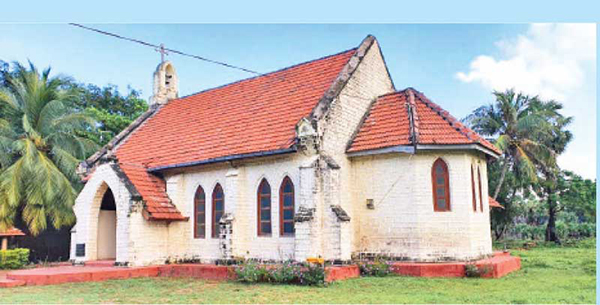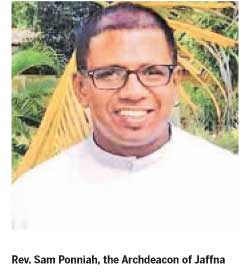St. Andrew’s Church Palai: 125 years of Christian witness-by Dishan Joseph

The Northern Province of Sri Lanka has been embellished with many churches. The Anglican Church (Church of Ceylon) has been active in Jaffna and other Northern areas for 200 years. The pioneer clergymen from the Church Missionary Society came and faithfully propagated the gospel. One of the lesser-known areas in the Northern region is the serene village of Palai, located 52 Km from Jaffna.
In the 1860s, not many from Colombo would have ventured to this remote village. It is a village dotted with fields and ponds. The first person to visit Palai is Rev. John Backus. He was keen to mingle with the Tamil-speaking people and understand their culture. He began his work in 1868 and conducted worship services in a hut. The hut was 20 feet by 12 feet. The people slowly responded to his kindness. They realized the need for a solid church and by October 15, 1889, the foundation stone was laid for a new church.
The new church was dedicated on November 30, 1895, St. Andrew’s Day. Old records indicate that this church was built at a cost of Rs. 11,000, which was a substantial amount during that era. The church had a devoted congregation of 230 Christians. The dedication service was a grand affair, with Psalms being read. The new church was duly adorned with teak tables, communion chalice and ciborium, teak lectern and cushions for kneeling. The Sunday School had 115 children from the Palai area. The first anniversary of St. Andrew’s Church was celebrated in 1896 with the participation of Rev. Carter, Principal of St. John’s College, Jaffna. Another priest associated with this church was Rev. Samuel Chelvanayakam. Rev. Victor Benjamin Muthuveloe took care of this church when he was the vicar at St. John’s Church, Chundikuli.
A church is not simply a building with a cross and stained glass windows, but is primarily a house of prayer and spiritual renewal. As the congregation grew, another priest named Rev. S.S. Richards served the parish with great zeal. Senior members today recall another remarkable priest Rev. J.T.N. Handy who travelled by car from Jaffna to Palai and packed his car with Christians on the way. He served St. Andrew’s Church from 1963 to 1970.
During this period, a project was launched in the church garden to teach weaving to women. This skills project was coordinated through the Social Services Department. This remote church realized the importance of vocational training to empower and duly emancipate rural women. This is a glowing example that can be followed even today by other churches across Sri Lanka, especially those serving rural com

munities. Another church that is associated since the 1860s with St. Andrew’s is the Church of Mary Magdalene located in the fishing village of Uduthurai.
Like many churches in the Northern Province, this small church was also subject to some restraints owing to the dark years of conflict. During the stewardship of Ven. Donald Canagaratnam, the church was reopened in 1990 with Rev. Jebaratnam visiting from Vavuniya. Former Bishop of Colombo Rt. Rev. Duleep de Chickera took a keen interest in St. Andrew’s Church and visited during the 2001–2004 period along with Rev. Nesakumar and looked after the welfare of this church and her congregation. In the years that followed there were few displacements that impacted the congregation in Palai. In 2010, the church was fully reopened under the care of Rev. P. Clay. Many families were given livelihood assistance via the Diocesan Board of Social Responsibility.
Commenting on the 125th anniversary, Rev. Sam Ponniah, the Archdeacon of Jaffna, said, “St. Andrew’s Church is a remnant of the legacy of the work of the CMS missionaries in Sri Lanka, particularly in the Northern Province. The CCTM schools started by them were taken over by the Government in 1960. Some of the schools in this area were subsequently closed due to the lack of student population – mainly due to the displacements. St. Andrew’s Church has had many starts and restarts due to the war. Now the congregation is growing steadily in numbers due to the resettlement of people in their native residences.
The parish is involved in the local community by running a pre-school. The parish has given 20 perches of land to the Water Board for the construction of a water tank, for providing water to the residents of the area. They have released another 20 perches to the Local Government authority for an Ayurveda hospital in order to promote indigenous medicine.
“These are our efforts to continue to share the resources that the Anglican community has inherited as we continue with the mission of sharing God’s love with neighbours. We thank God for his divine blessings,” Rev. Ponniah said. This beautiful church remains a spiritual beacon to the community of Palai.







